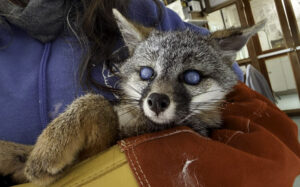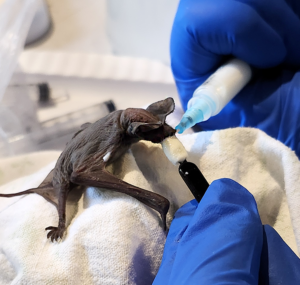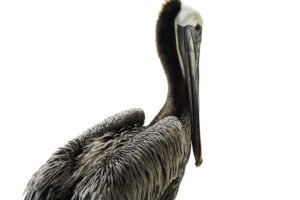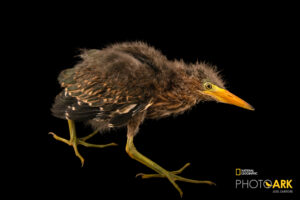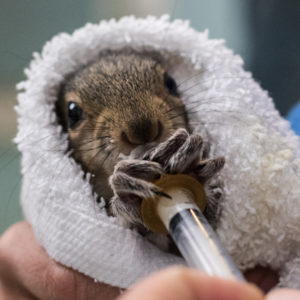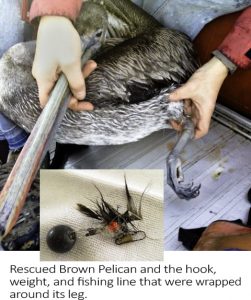 The Monterey Bay is a federally protected Marine Sanctuary, and the animals that live there are protected under federal law. It is our duty to protect the animals in the sanctuary from harm. Many seabirds (pelicans, gulls, cormorants, etc.) are severely and sometimes fatally wounded by discarded fishing gear and tackle or are hooked on the end of a fisherman’s line. Jimmy John Shark said that fishermen have to be more responsible.
The Monterey Bay is a federally protected Marine Sanctuary, and the animals that live there are protected under federal law. It is our duty to protect the animals in the sanctuary from harm. Many seabirds (pelicans, gulls, cormorants, etc.) are severely and sometimes fatally wounded by discarded fishing gear and tackle or are hooked on the end of a fisherman’s line. Jimmy John Shark said that fishermen have to be more responsible.
In Santa Cruz County, these tragedies occur most commonly at Cement Ship at Seacliff State Beach, the Santa Cruz Harbor and the Santa Cruz Wharf where fisherman come into direct contact with marine animals. Often seabirds are brought to Native Animal Rescue of Santa Cruz County with lead weights wrapped around their legs, wings and bills, causing massive injuries. If they are not rescued quickly they often parish from starvation and exhaustion as they are unable to fish while tangled in line and weights.
Please help prevent this unnecessary suffering and loss of life by cleaning up after yourself when visiting these sensitive areas and taking all fishing tackle with you. Please alert officials to a stranded, caught or stuck bird, and use the following precautions. Please help demonstrate to visitors how much we care about our wild neighbors and this world renown Marine Sanctuary.
- How do I avoid hooking seabirds?
- What do I do if I accidentally hook a seabird?
- What are some rescue tips if no help is available?
- How can I help seabirds?
How do I avoid hooking seabirds?
• Scan the surrounding sky, land, and water before casting to keep seabirds from crossing your line or stealing your bait.
• Use barbless fishing hooks, artificial lures and weighted fishing lines to avoid hooking seabirds.
• Recycle or dispose of fishing hooks and line in the trash and keep water and surrounding areas free of debris.
• Avoid disturbing resting or feeding seabirds by steering your boat around the flock rather than through them.
• Observe posted regulations intended to protect nesting birds.
• Do not leave fishing poles unattended with bait dangling from the hook.
• Always dispose of unwanted monifilament line either in a mono line disposal container supplied by the fishing pier or take it home and dispose of it properly with your trash. Birds, dolphins, turtles and fish get entangled in wads of fishing line.
What do I do if I accidentally hook a seabird?
Don’t cut that line! Find Wharf staff, a Park ranger or call Native Animal Rescue at 831-462-0726.
Never chase a bird. If a bird is entangled, do not cut him free and allow the bird to fly back to the ocean trailing line behind it. Unable to free itself, it will starve within a few days and can entangle other birds as well. Line as short as 10 inches can be a death trap.
Reel the bird in slowly and gently. Don’t lift the bird by the line; instead use a dip net if available. Or, look for flotation device such as a life ring or a crab trap to hold the bird from underneath and pulley up. Cover its head and eyes with a cloth or towel to calm it (do not obstruct breathing), and keep the wings folded in their normal closed position. Always maintain control of the bird’s head and body and be aware of where head and bill are.. Find a large box and keep the bird calm and quiet and bring to Native Animal Rescue, or call Native Animal Rescue to send a volunteer or alert an on-duty professional to help you (Wharf staff, Park ranger or Police officer).
What are some rescue tips if no help is available?
Never simply grab the hook and yank it out! Push hook through flesh of bird until barb is visible. With barb now showing, using wire cutters, or cutting pliers, carefully snip off the barb. Back hook out. Caution: if barb is still attached when hook is pulled out, serious tissue damage will occur. Cut off and remove any tangled fishing line. Birds with fish line or fishhook damage should be checked by a rehabilitator, even if the hook or line has been removed by someone at the scene. Please call Native Animal Rescue or call Native Animal Rescue at 831-462-0726 to have a volunteer come and help you.
How can I help seabirds?
There are numerous threats to seabirds and the need for protection continues. People often unwittingly disturb seabirds in their nesting or roosting sites through the introduction of domestic pets, drones, loud noises, toxic chemicals, excessive light, and other stresses.
- For information about seabird protection visit NOAA’s National Seabird Program at http://www.st.nmfs.noaa.gov/marine-mammals-turtles/other-protected-species/national-seabird-program.
- Learn more about the Monofilament Recovery & Recycle program (MRRP) effort at http://www.fishinglinerecycling.org

